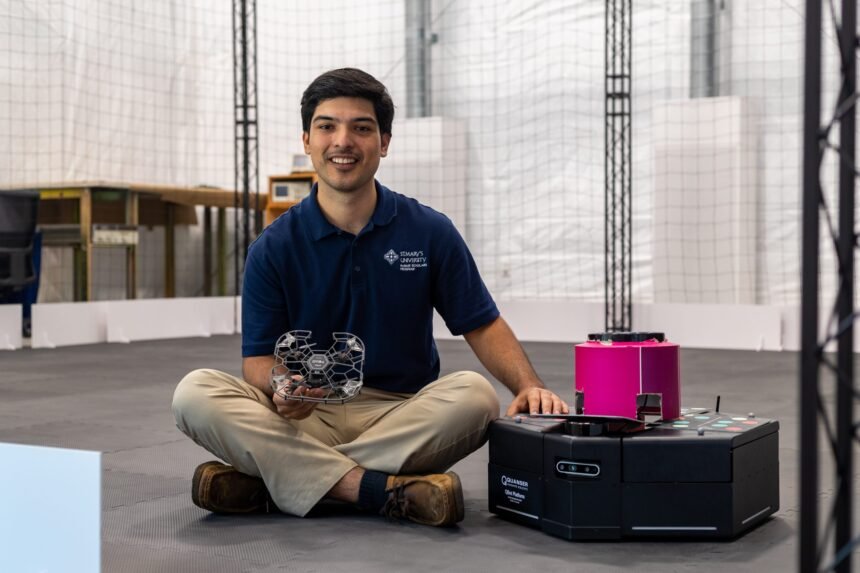Joshua Riojas clearly remembers the day he bumped into a particular building at St. Mary’s University a few years back. He was taking a self-guided campus tour, he said, when he suddenly saw a big, blue, metal structure with a word in its name that sparked curiosity: Unmanned.
It was the Unmanned Aerial Systems Lab, a lab built by the university in 2021 to incorporate drones and drone-related research into their Science, Engineering and Technology curriculum.
Riojas, now a 22-year-old computer engineering major at St. Mary’s, knew he wanted to work in this lab. What he didn’t know is that only a couple of years later he would be developing machine learning models — an AI subfield that seeks to train algorithms to make predictions based on data and statistical methods.
His research seeks to help keep unmanned aerial vehicles up in the air longer, in hopes these can one day be deployed for lengthy survey or search missions, like those happening after the floods in Kerr County.
“I’m pretty sure you have seen on social media, ‘Why wouldn’t they deploy drones for search and rescue missions?’” Riojas said. “And the simple answer is that they can’t last long in the air due to power issues.”
Engineers at St. Mary’s University helped secure a grant in October 2024 totaling more than $340,000 from the U.S. Department of Defense to purchase autonomous vehicles, including flying drones and ground vehicles for this and other research projects.
“This grant enables us to do research on autonomous vehicles, AI and overall security,” said Wenbin Luo, Ph.D., professor of computer engineering at St. Mary’s. “In addition, we also want to use it as a teaching platform, so we can use what we learn and pass the knowledge on to our students.”
While Luo and other professors and students focus on research to keep autonomous vehicles safe from cyberattacks, the question for Riojas became: How do you help keep these machines up in the air longer?
“The only solution to having a system that can stay aloft in the air for a long period of time is a sailplane, because they use the wind to stay aloft for a longer period of time,” Riojas said.
That meant he had to figure out how to teach the machines to read air currents, seek air patterns and use those patterns like a bird would, to stay in flight without expending too much energy.
“In this case, Joshua is creating data,” said Ben Abbott, the engineering lecturer overseeing Riojas’ work in the lab. “He is trying to create a machine learning — in this age of AI that we’re in — that can become as smart as the bird, smarter than humans.”

The U.S. Department of Defense offers grants to higher education institutions to support research that can be critical to national security. In fiscal year 2025, the agency spent more than $5 billion on grants and awarded more than 2,000 new grants, according to data released by USAspending.
In this case the grant was secured by St. Mary’s to help support cybersecurity research, specifically how to keep unmanned vehicles safe, but having this equipment offers a wide array of other research possibilities, Abbott and Luo said.
In his research Riojas created data by reading air patterns himself, such as the direction of a current, the velocity of it, and combining this with how a drone would react to a specific current; for example, where in the particular current would a drone fly in a more stable way? What data points could he gather from even the most minuscule movement caused by air fluctuations or change in position?
To do that, he attached motion caption markers to a flying drone and asked it to follow a vehicle on the ground with a fan attached to it using sensors. He then recorded the data it was receiving from the drone’s movement including its exact location within that rising air current.

“I just found it very interesting how accurate the machine learning models that you build can be,” Riojas said. “If that drone is at the very center of that rising air, then it’ll tell you that it’s at the center. But if it’s at the edge of it, then it’ll tell you because it’s going to be looking at the roll, pitch and yaw.”
With his professor looking attentively, Riojas controlled only the ground robot to move around the flight area in the lab, blowing air as it roamed. A small drone then followed its movement closely, seeking to stay near the center of the rising air as it gathered data with its movements.
With this research Riojas and his professors hope to one day inform many other unmanned aerial vehicles how to stay in the air longer and make a difference in potentially life-saving missions.
This is also one example of why Abbott sees working with AI as a requirement in his courses. He wants to provide his students hands-on experience so that they learn to use AI as a tool to solve real-life problem.
“Well, what we’re learning here … is how to use the AI,” Abbott said. “I mean, Joshua, he doesn’t know it yet, but he can compete with anyone.”













